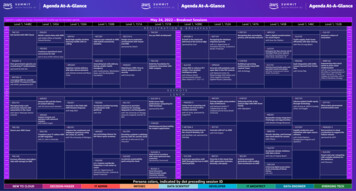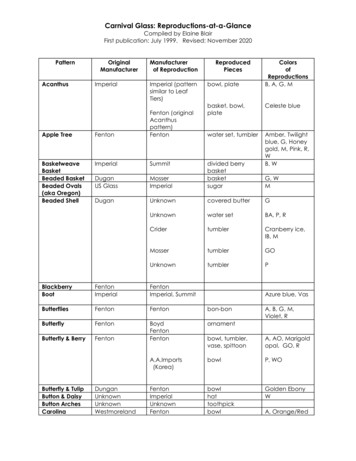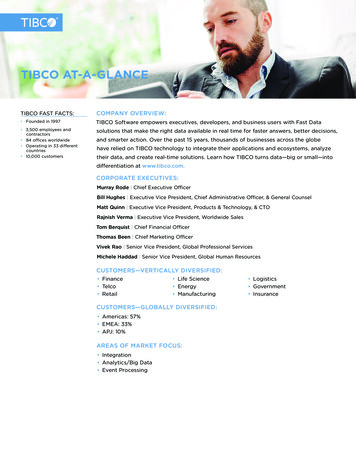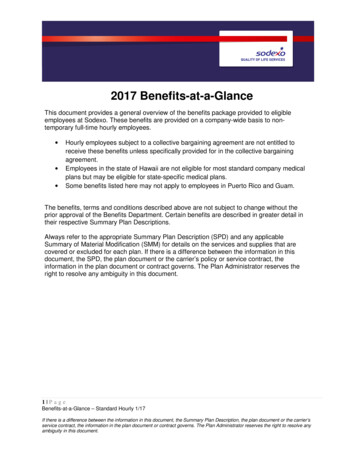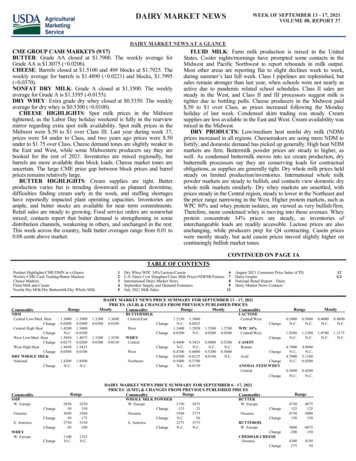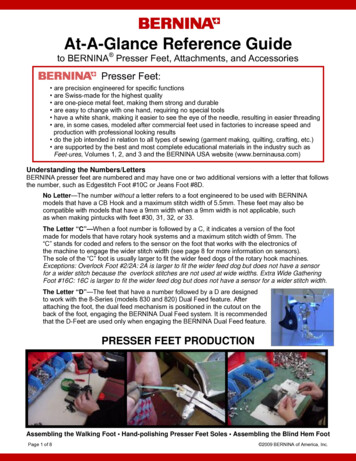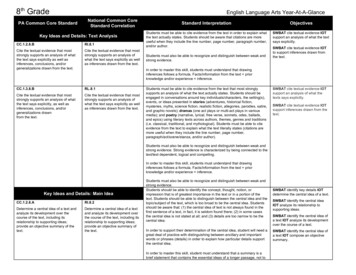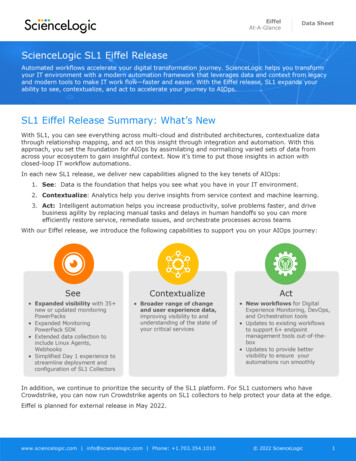
Transcription
EiffelAt-A-GlanceData SheetScienceLogic SL1 Eiffel ReleaseAutomated workflows accelerate your digital transformation journey. ScienceLogic helps you transformyour IT environment with a modern automation framework that leverages data and context from legacyand modern tools to make IT work flow—faster and easier. With the Eiffel release, SL1 expands yourability to see, contextualize, and act to accelerate your journey to AIOps.SL1 Eiffel Release Summary: What’s NewWith SL1, you can see everything across multi-cloud and distributed architectures, contextualize datathrough relationship mapping, and act on this insight through integration and automation. With thisapproach, you set the foundation for AIOps by assimilating and normalizing varied sets of data fromacross your ecosystem to gain insightful context. Now it’s time to put those insights in action withclosed-loop IT workflow automations.In each new SL1 release, we deliver new capabilities aligned to the key tenets of AIOps:1. See: Data is the foundation that helps you see what you have in your IT environment.2. Contextualize: Analytics help you derive insights from service context and machine learning.3. Act: Intelligent automation helps you increase productivity, solve problems faster, and drivebusiness agility by replacing manual tasks and delays in human handoffs so you can moreefficiently restore service, remediate issues, and orchestrate processes across teamsWith our Eiffel release, we introduce the following capabilities to support you on your AIOps journey:See Expanded visibility with 35 new or updated monitoringPowerPacks Expanded MonitoringPowerPack SDK Extended data collection toinclude Linux Agents,Webhooks Simplified Day 1 experience tostreamline deployment andconfiguration of SL1 CollectorsContextualize Broader range of changeand user experience data,improving visibility to andunderstanding of the state ofyour critical servicesAct New workflows for DigitalExperience Monitoring, DevOps,and Orchestration tools Updates to existing workflowsto support 6 endpointmanagement tools out-of-thebox Updates to provide bettervisibility to ensure yourautomations run smoothlyIn addition, we continue to prioritize the security of the SL1 platform. For SL1 customers who haveCrowdstrike, you can now run Crowdstrike agents on SL1 collectors to help protect your data at the edge.Eiffel is planned for external release in May 2022.www.sciencelogic.com info@sciencelogic.com Phone: 1.703.354.1010 2022 ScienceLogic1
EiffelAt-A-GlanceData SheetLet’s take a deeper look at the SL1 Eiffel release capabilities across the See, Contextualize and Act pillars:See: Extending observability with a more complete view of what’simpacting your service healthSL1 offers hundreds of monitoring PowerPacks, pre-built monitoring applications that help you see whatyou have, know what’s working and what’s not, so you can take corrective actions. In the Eiffel release,we expand our monitoring capabilities for a more complete view of your environment: Updates to more than 35 PowerPacks to ensure a more complete view of your Cisco, Meraki, PaloAlto Networks and Aruba networking environments, as well as updates to expand visibility in yourapplication environment including Microsoft Office 365, Cisco ThousandEyes, IBM and Docker. New networking PowerPack to support VMware NSX-T software-defined networking solution Expanded cloud services monitoring capabilities for Azure, AWS, and Google Cloud:oAzure: now monitors over 170 servicesoAWS: WorkspacesoGoogle Cloud: BigQueryWhile we have prebuilt templates with our PowerPacks, every environment is different and you may wantto develop your own integration to SL1. For that we have our low-code SDK. In the Eiffel release, we addthe ability to support CLI and REST to further help you quickly develop custom SL1 integrations.www.sciencelogic.com info@sciencelogic.com Phone: 1.703.354.1010 2022 ScienceLogic2
EiffelAt-A-GlanceData SheetContextualize: Accelerate root cause analysis with machine-driven,service-centric insightsPinpointing the source of an issue can consume tons of troubleshooting time, delaying your ability toaccurately inform your stakeholders of a potential issue, and extending the time to resolution. Being ableto correlate metrics quickly is crucial. SL1 already correlates a wide variety of data such as topology,events, anomalies, configuration, and more across your ecosystem. With our Duomo release in 2021, weintroduced the ability to bring change data into your behavioral correlation analysis.With the Eiffel release, we now capture ServiceNow emergency change data and RestorePointchanges. The image below illustrates how change data is captured in SL1 to aid in root cause analysis:SL1 now shows Restorepoint and ServiceNow changes in the “Change” tab on the business servicedashboard. In this example, you can see the device service is unhealthy and degraded, and you can seethat a change was recently made. You can investigate further by clicking to open the ServiceNow changeticket.Act: Move faster with automated workflowsAutomated workflows are the fastest way to increase your productivity and accelerate your journey toAIOps. That’s why our Eiffel release includes enhancements to our out-of-the-box closed-loop workflowautomation solutions that connect ecosystems and drive collaboration between ITOps, DevOps and ITSM.With the Eiffel release and future releases, we continue to expand our library of closed-loop workflowautomation solutions to include additional ecosystem management tools and best practices.www.sciencelogic.com info@sciencelogic.com Phone: 1.703.354.1010 2022 ScienceLogic3
EiffelAt-A-GlanceData SheetNew ecosystem tool support in the Eiffel release includes: CMDB/Inventory workflows: InfloBlox IP Address Management (IPAM) Incident/Notification workflows: Atlassian Jira, WebEx Teams, AWS Incident Manager, AzureSentinel Configuration and Change Management workflows: ServiceNow, Restorepoint Orchestration workflows: Ansible, Chef, Azure DevOps workflows: Atlassian Bitbucket, JenkinsNew closed loop workflow automation solutions available today (green dots) and planned for Q2 2022 (yellowdots) drive faster incident resolution processes and more efficient handoffs between IT Ops, DevOps, and ITSMteams.Digital Experience Management (DEM) is another area we’ve added in this release, and it’s a greatexample of how our “better together” tools deliver improved insight into your environment. While digitalexperience monitoring tools like Cisco ThousandEyes reveal what users are actually experiencing with yourdigital services, they’re even more powerful when combined with a full-stack service monitoring platformlike SL1 that exposes what infrastructure or application elements are impacting that experience.When ScienceLogic SL1 is deployed alongside Cisco ThousandEyes, you can monitor the entireinfrastructure stack and network connectivity that supports your mission-critical applications and users.SL1 provides an inside-out view with minimal overlap with digital experience monitoring tools likeThousandEyes that provide an outside-in view. SL1 support for Cisco ThousandEyes is available today.In addition, we are evaluating future support for tools in the areas of BI/analytics/reporting and Security.www.sciencelogic.com info@sciencelogic.com Phone: 1.703.354.1010 2022 ScienceLogic4
EiffelAt-A-GlanceData SheetAutomation library of best practicesTo further help you accelerate your troubleshooting and remediation efforts, SL1 provides 350 bestpractices and 240 recommended actions; we’ve added over 50 new recommended actions for Cisco UCS,Citrix, F5, NetApp, and Juniper. This library of best practice automation policies for troubleshooting andremediation help you move fast to avoid, troubleshoot, or remediate issues.Putting it all togetherHow do SL1 and our new Eiffel capabilities work together to help you reduce mean time to repair (MTTR)and offload your team so they can support more strategic activities for your organization? Let’s look at atypical example of a network quality of service degradation due to a configuration change.Scenario: Auto-troubleshoot and repair change for NetOps workflowIT teams are frequently burdened with repetitive support issues, such as a network degradation that couldpotentially impact a business service. Often those kinds of issues arise from something simple: a changesomewhere on the network that inadvertently impacts quality of service. Through automation, IT teamscan resolve problems quickly before the issue becomes business-impacting.Before: Coordinating across multiple tools results in long resolution timesOnce a network degradation issue is determined, manual processes are put into play, crossing multiple ITtools—change management, service desk, notification, collaboration—slowing down problem resolution.These processes require repetitive, error-prone data capture, entry, and analysis to correlate informationacross tools and keep stakeholders informed. Add to that the time delays for staff to see and respond. ITteams, overburdened and struggling with a skills shortage, need a more efficient way to manage serviceimpacting issues.www.sciencelogic.com info@sciencelogic.com Phone: 1.703.354.1010 2022 ScienceLogic5
EiffelAt-A-GlanceData SheetAfter: Automated workflowsWith the combined SL1 workflows for Configuration and Change plus Incident/Notification, SL1 eliminatesmany of those manual processes.Operational workflows are automated across tools, eliminating the need to switch between applicationsand speeding the process. SL1 captures key elements of workflow, such as populating the event withactual configuration changes made, providing a recommendation to roll back the configuration change,and automatically executing the recommendation once approved by the operator. It keeps everyoneinformed along the way, allowing quick case validation and closure with minimal to no humaninvolvement.As a result, you can achieve lower MTTR with cross-tool communication and routine task automation.Internal stakeholders benefit from automatic communications so they can mitigate any potential businessimpacting issues. You greatly reduce troubleshooting time by eliminating the need to manually siftthrough various change information to determine potential cause of the issue. And by automating theseroutine workflows, you can better focus your skilled IT specialists on more strategic business issues.Take the next step in your AIOps journey todayFor more info on these new updates, contact us! And, if you are exploring your next steps on your AIOpsjourney, check out our Getting Started page and get expert insights by attending a webinar. Existingcustomers can contact your account representative and visit the “What’s New” section of the ScienceLogicSupport website.About ScienceLogicThe ScienceLogic SL1 platform enables companies to digitally transform themselves by removing thedifficulty of managing complex, distributed IT services. Our IT infrastructure monitoring and AIOpsplatform (SL1) provides modern IT operations with actionable insights to predict and resolve problemsfaster in a digital, ephemeral world. The SL1 platform sees everything across cloud and distributedarchitectures, contextualizes data through relationship mapping, and acts on this insight throughintegration and automation. SL1 solves the challenges and complexities of today and provides theflexibility to face the IT monitoring and management needs of tomorrow. Trusted by thousands oforganizations, ScienceLogic’s technology was designed for the rigorous security requirements of UnitedStates Department of Defense, proven for scale by the world’s largest service providers, and optimizedfor the needs of large enterprises.www.sciencelogic.com info@sciencelogic.com Phone: 1.703.354.1010 2022 ScienceLogic6
Pinpointing the source of an issue can consume tons of troubleshooting time, delaying your ability to accurately inform your stakeholders of a potential issue, and extending the time to resolution. Being able to correlate metrics quickly is crucial. SL1 already correlates a wide variety of data such as topology,
